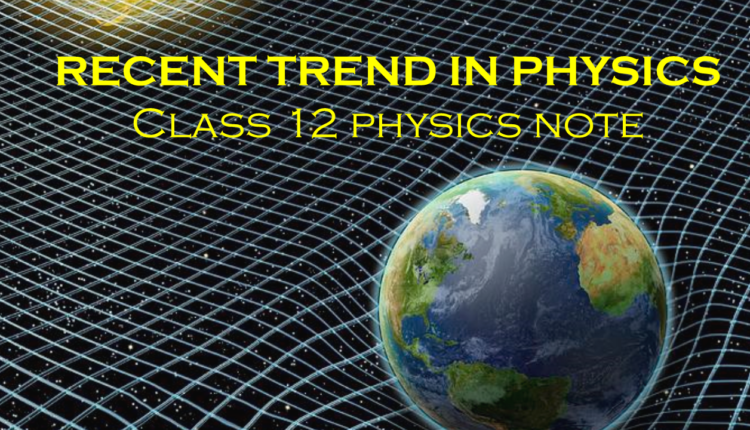GRAVITATIONAL WAVE [First proposed by Henri Poincare in 1905.]
Definition: Gravitational waves are invisible ripples in space that travel at the speed of light and interact very weakly with matter.
- These wave squeeze and stretch anything in their path as they pass by.
- Gravitational waves are an invisible disturbance in the curvature of space-time, generated by accelerated masses.
- Gravitational waves are an invisible disturbance in the curvature of space-time, generated by accelerated masses.
- Gravitational waves are incredibly fast-they travel at the speed of light . These waves squeeze and stretch anything in their path as they pass by.
- Gravitational waves transport energy as gravitational radiation (they propagate gravity).
Note: In 1916, in general theory of relativity (GTR), Albert Einstein theorized (predicted) that when objects move through space, they create waves in space time around them.
He believed that this kind of movement could cause ripples in space. These ripple waves move outward, like ripples from a stone moving across the surface of a pond. Scientists call these ripples of space as gravitational waves.
Importance of Gravitational wave:
- Gravitational waves carry information about their origin (origin of universe) and about the fundamental properties of gravity that can’t be seen through observations of the electromagnetic spectrum.
- It helps to provide the information about the measure of expansion of universe.
- It helps to estimate the future of universe (origin and end of universe).
- The discovery of gravitational wave may lead to the discovery of new devices and technologies.
Note: Imagine the use of electromagnetic waves in our daily lives!!!!
Different parts of the EM spectrum have different uses:
- Gamma rays – Medical imaging and treatments
- X-rays – Medical imaging and treatments
- Ultraviolet – Energy efficient lamps, sun tanning
- Visible light – Fiber optic communications
- Infrared – Electrical heaters, cooking food and infrared cameras
- Microwaves – satellite communications and cooking food
- Radio waves – radio and television
How are gravitational waves produced?
The most powerful gravitational waves are created when objects move at very high speeds. Some examples of events that could cause a gravitational wave are:
- when a star explodes asymmetrically (called a supernova).
- when two big stars orbit each other (two stars- binary stars).
- when two black hole orbit each other and merge.
- Gravitational waves generated by less massive objects- like our solar system- is undetectable.
Properties of gravitational wave:
- It is an invisible ripple in space that travels at the speed of light.
- These waves squeeze and stretch anything in their path.
- These waves interact very weakly with matter, so it can easily penetrate the materials.
- These waves obey inverse square law.
- The quantum of gravitational wave is called as graviton (not discovered yet).
Note:
- The quantum of electromagnetic wave is photon.
- The Quantum of sound wave is phonon.
Related questions:
- What are gravitational waves? What causes gravitational wave?
- What are the properties and importance of gravitational waves? Do gravitational waves affect time?
- Does Newton’s laws of universal gravitation provide existence of gravitational wave?
- What are gravitational waves? Who proposed the concept of gravitational wave? When was gravitational wave first detected?
- What is space time? Explain gravity in terms of space time? How will you demonstrate that the gravity of black hole is intense?
First direct observation of gravitational wave:
1.3 billion years earlier, two massive black holes collided. The collision released massive amounts of energy in a fraction of a second (about 50 times as luminous as all the stars in the visible universe combined) and sent gravitational waves in all directions.
On September 14, 2015 those waves reached Earth and were detected by researchers at the Laser Interferometer Gravitational-Wave Observatory (LIGO).

Gravity:
Gravity is the effect of matter on space time. [ Gravity is the distortion of space time by mass.]
A matter at a point would curve (bend) the space-time fabric around it. Larger the mass, deeper will be the curvature.
General theory of relativity says: Gravity is the curvature of space-time. An object in space bends the space-time fabric. This bending gives rise to gravity. Hence more the mass more is the bending, means more gravity.
Black hole is a very dense object in space-time, which means it has large mass in small volume. Hence, it bends the fabric to the great extent.
Higgs boson: [Proposed by Peter Higgs in 1964]
Definition:
A carrier particle of Higgs field, which is responsible for the origin of mass in elementary particles (leptons and quarks), is called as Higgs boson.
In standard model of elementary particle, the Higgs particle is a massive scalar boson with no electric charge, no color charge and have zero spin.
The Higgs boson is an excitation of the Higgs field that helps other particles (leptons and quarks) to pass through the field and hence provide mass to the particles.
Properties of Higgs boson:
- It is the carrier (mediating particle) of Higgs field.
- Higgs boson provides mass to other fundamental particles.
- It has zero electric charge.
- It is nicknamed as Goddamn particle- God particle.
- It has very short life.
- It has zero spin.
Candidate of Higgs boson events was observed from collisions between two protons in Large Hadron Collider (LHC) in 2012.
Higgs boson is very unstable, that decays immediately into other particles (decays into Z bosons, which then decays into an electron plus positron and muon plus anti muon).
The nickname “God Particle” for Higgs Boson is suitable in the sense that it provides mass to the elementary particles like electrons and quarks.
Nobel Prize-winning physicist Leon Lederman referred to the Higgs as the “Goddamn Particle”. The name was meant to poke fun at how difficult it was to detect the particle. Later, the word is paraphrased as “God particle”.
Some physicists think there could be several different types of Higgs bosons and this is just the first one we’ve detected.
Higgs Field:
The Higgs field is a field of energy that is thought to exist in every region of the universe, even throughout the empty space.
The field is mediated by a fundamental particle known as the Higgs boson, which is used by the field to continuously interact with other particles, such as the electrons and quarks.
As particles (leptons and quarks), move through the Higgs field, they interact with the Higgs bosons, which cling to or cluster around the matter particles, and give them their mass. The more Higgs boson particles that interact with the other particle, the more mass it attains.
Only photons and gluons do not interact with the Higgs boson.
- Neutrinos, the lightest particles with almost zero mass, barely interact with a Higgs boson.
- Top quarks, which have about the mass of a gold atom, have the strongest interaction with a Higgs boson.
The existence of Higgs boson revealed that” mass is an acquired property (via interaction with Higgs field) but not an intrinsic property of particles.
Earthquake:
Definition: An earthquake is the shaking of the surface of the earth resulting from a sudden release of energy from the interior of the earth.
An earthquake may case several destructions. However, it helps us to know about internal structure of earth.
Earthquake can range in magnitude from those that are so weak that they can’t be noticed (
to those that cause violent destructions ().
- The earthquake that occurred in Nepal in 2015 (named as: Gorkha earthquake) was of magnitude 7.8 Richter Scale.
Causes of earthquake:
The main reason for the occurrence of earthquake is the movement of Tectonic plates (massive irregular shaped slab of solid rocks).
The earthquakes originate in tectonic plate boundary.
- The tectonic plates under the ocean are known as Oceanic Plates.
- The tectonic plates under the continental are known as Continental Plates.
BASIC TERMS RELATED TO EARTHQUAKE
Hypocenter (Focus): [Earthquake focus / Focal point]: The point of origin of an earthquake.
- A point beneath the Earth’s surface where the vibrations of an earthquake originates.
- The hypocenter corresponds to the location where the motion on a fault surface starts.
- The focal depth of earthquake hypocenters may vary from the surface down to nearly 700 km
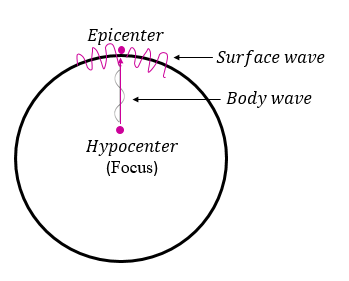
Epicenter: The point on the earth’s surface vertically above the focus of an earthquake.
Seismology: The branch of science which deals with the scientific study of earthquake is called seismology.
Seismograph Seismographs are instruments used to record the motion of the ground during an earthquake. They are installed in the ground throughout the world and operated as part of a seismographic network.
Seismogram: A seismogram is a graph output by a seismograph. It is a record of the ground motion at a measuring station as a function of time.
Seismic Waves: Seismic waves are the vibrations from earthquakes that travels through the earth.
Types of Seismic waves: Seismic waves propagate through the inner layer of the earth and also propagate along the surface of wave.
A. Body wave: [P wave and S wave]
Those seismic wave that travels through the interior layers of the earth.
- They travel faster than surface wave
- They have higher frequency
- They can be longitudinal as well as transverse.
- Longitudinal waves are called P waves or primary wave
- Transverse body wave are called S wave or secondary waves.
1. P Wave:
It travels through the solid rocks and fluid present inside earth. It pushes and pulls the rocks in the direction of the propagation of the wave and produces compressions. So, this wave is also called the compression wave.
- These wave travels at high speed so are the first wave to be recorded in seismic station (6 to 8 km per sec) and called as primary wave.
- Their amplitude goes on decreasing as they get farther from their source.
- During propagation of wave, particles also move along the direction of the wave. So P waves are called longitudinal wave.
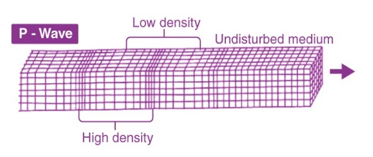
2. S Wave:
It is called as secondary wave because these wave are the second waves to be recorded on the seismic station.
- These wave travel much slower than P wave (about 3.5 km per sec) and can propagate through solid only.
- During propagation the particles moves in a direction perpendicular to the direction of propagation of wave so called transverse waves.
These wave cannot travel through liquid (due to lack of shear strength in liquid) but can travel through solid so called as shear waves.
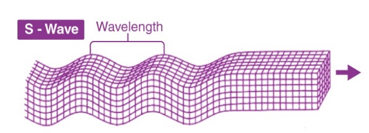
B. Surface Wave
These seismic waves travel along the surface of the earth. Like ripple wave in water.
- They have low frequency and arrives later than body wave.
- Surface waves spread out slowly and their energy is confined to a smaller volume on surface.
- Wave amplitude is greater than body wave.
- These wave are almost responsible for the damage and destruction during the earthquakes.
Surface waves are classified under various categories among them most common are:
- Love wave
- Rayleigh Wave
1. Love Wave:
These are the fastest surface waves, which produces entirely the horizontal motion.
- During the propagation of the wave, the ground moves side to side in a horizontal plane but perpendicular to the direction of propagation of wave.
- This wave particularly damages the foundation of the structure and cause horizontal shearing of the ground.
- This cannot propagate through liquids.

2. Rayleigh Wave:
The wave produces up and down, and side to side, movement of the ground in the same direction along which the wave is moving. Like ripples in sea or ocean.
- The wave moves in both vertical and horizontal plane pointing direction of wave propagation.
- Much of the shaking of the ground is felt due to this wave.
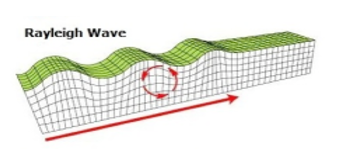
GORKHA EARTHQUAKE
Nepal is a seismically active region situated between Indian and Eurasian plates of the world where a devastating earthquake has occurred in the past.
In April 25 2015, Earthquake struck in Nepal with a magnitude of 7.8 Mw at 11:56 AM local time with epicenter at Barpak, Gorkha. The earthquake was 28.2300N and 84.7310E at depth about 8.2Km. This was later named “Gorkha earthquake”. This killed nearly 9000 people and injured nearly 22000.
The main shock was followed by two large aftershocks of Mw 6.7 (on 26 April 2015) and Mw 7.3 (on 12 May)
According to USGS (United States Geological Survey), Gorkha earthquake was caused by a sudden thrust, or release of built up stress along the major fault line where Indian plate is slowly diving underneath the Eurasian plate.
- Gorkha earthquake destroyed many buildings and infrastructure in urban and rural areas.
- Numerous landslides and rock falls in the mountain areas, blocking roads and hampering rescue and recovery activities.
Nanotechnology
Nanotechnology, shortened to ‘nanotech’, is the study of the control of matter in an atomic and molecular scale.
Generally, nanotechnology deals with structure of the size 100 nanometer or small, and involves developing materials or devices within that size.
Nanotechnology is very diverse.
Note: The ideas and concepts behind nanoscience and nanotechnology started with a talk entitled “There’s Plenty of Room at the Bottom” by physicist Richard Feynman at an American Physical Society meeting at the California Institute of Technology (Cal Tech) on December 29, 1959, In his talk, Feynman described a process in which scientists would be able to manipulate and control individual atoms and molecules.
Some applications of nanotechnology are:
- Everyday Materials
- Medical and Healthcare
- Electronics and IT
- Environmental
- Transportation
Everyday Materials
- Nanoscale additives to or surface treatments of fabrics can provide lightweight ballistic energy deflection in personal body armor, or can help them resist wrinkling, staining, and bacterial growth.
- Clear nanoscale films on eyeglasses, computer and camera displays, windows, and other surfaces can make them water and residue-repellent, antireflective, self-cleaning, resistant to ultraviolet or infrared light, antifog, antimicrobial, scratch-resistant, or electrically conductive.
- Nanoscale materials are beginning to enable washable, durable “smart fabrics” equipped with flexible nanoscale sensors and electronics with capabilities for health monitoring, solar energy capture, and energy harvesting through movement.
- Light weighting of cars, trucks, airplanes, boats, and space craft could lead to significant fuel savings.
- Nanotechnology is already being used to develop many new kinds of batteries that are quicker-charging, more efficient, lighter weight, have a higher power density, and hold electrical charge longer.
- Nano-bioengineering of enzymes is aiming to enable conversion of cellulose from wood chips, corn stalks, unfertilized perennial grasses, etc., into ethanol for fuel.
Electronics and IT
- Transistors, the basic switches that enable all modern computing, have gotten smaller and smaller through nanotechnology
- Using magnetic random access memory (MRAM), computers will be able to “boot” almost instantly. MRAM is enabled by nanometer‐scale magnetic tunnel junctions and can quickly and effectively save data during a system shutdown or enable resume‐play features.
- Ultra-high definition displays and televisions are now being sold that use quantum dots to produce more vibrant colors while being more energy efficient.
- Flexible, bendable, foldable, roll able, and stretchable electronics are reaching into various sectors and are being integrated into a variety of products.
Medical and Healthcare
- Nano medicine diagnosis, drug delivery and tissue engineering are the important uses of the nanotechnology in medicine.
- Nanomaterials show very high efficiency in destroying cancer cells and are already undergoing clinical trials.
- Better imaging and diagnostic tools enabled by nanotechnology are paving the way for earlier diagnosis, more individualized treatment options.
- Nano medicine researchers are looking at ways that nanotechnology can improve vaccines, including vaccine delivery without the use of needles.
Environmental
- Nanotechnology could help meet the need for affordable, clean drinking water through rapid, low-cost detection and treatment of impurities in water.
- Nanoparticles are being developed to clean industrial water pollutants in ground water through chemical reactions that render the pollutants harmless. This process would cost less than methods that require pumping the water out of the ground for treatment.
- Researchers have developed a Nano fabric “paper towel” woven from tiny wires of potassium manganese oxide that can absorb 20 times its weight in oil for cleanup applications.
- Many airplane cabin and other types of air filters are nanotechnology-based filters that allow “mechanical filtration,” in which the fiber material creates nanoscale pores that trap particles larger than the size of the pore.
- Nanotechnology-enabled sensors and solutions are now able to detect and identify chemical or biological agents in the air and soil with much higher sensitivity than ever before.
- Another sensor has been developed by NASA as a smartphone extension that firefighters can use to monitor air quality around fires.
Transportation
- Nanotechnology offers the promise of developing multifunctional materials that will contribute to building and maintaining lighter, safer, smarter, and more efficient vehicles, aircraft, spacecraft, and ships.
- In addition, nanotechnology offers various means to improve the transportation infrastructure, Nano-engineered materials in automotive products include polymer nanocomposites structural parts; high-power rechargeable battery systems; thermoelectric materials for temperature control; lower rolling-resistance tires; high-efficiency/low-cost sensors and electronics; thin-film smart solar panels; and fuel additives and improved catalytic converters for cleaner exhaust and extended range.
- Nano-engineering of aluminum, steel, asphalt, concrete and other cementitious materials, and their recycled forms offers great promise in terms of improving the performance and longevity of highway and transportation infrastructure components while reducing their life cycle cost
- Catalysis, Nano-filtration are its uses in chemistry.
- It is also used in heavy industries like aerospace, construction, refineries, vehicles manufacturing etc.

